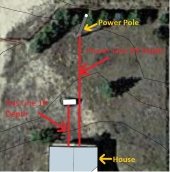John C Daley wrote:I have to ask a few questions, my signature has a link to rainfall catchment and use topics.
- why is the tank 100 feet away?
- 90mm to 100mm pipe is best to use.
- Are you fitting leaf separators at the building?
- are you installing total system drain points anywhere along the system to clear blockages away?
- will the horizontal pipe have any slope?
- what is the ball valve for?
- what size is it?
- a 5000 gal tank is really the starting size needed for a tank if you are using a lot of water. Min. 3 months usage.
- with a 1800 gal downpour your 1500 gal tank will overflow and you will loose the benefits of the whole system.
in Australia with 18 inches of rainfall, I have 2 / 5000gal tanks.
John,
I omitted a lot of details for simplicity since I am mostly concerned about the pipe system being sized for a worst-case downpour (with a factor of safety) and causing an input-side overflow. I am happy you are interested and your expertise is valuable in case I incorrectly designed or omitted anything. I also looked over the link on your signature block. You certainly are an expert at rainwater collection!
- The tank is 100 feet away since the area close to the downspouts already has plants, trees, and other things that my wife will not be happy if I removed. It is definitely not an optimal system, but 100 feet away is the closest she will allow.
- I was considering the larger diameter pipe 4" (about 100mm) PVC pipe. So that is an option and still wondering how much flow could a 4" system handle?
- The leaf/debris separators are immediately before the vertical enclosed PVC pipe system.
-The horizontal pipes will not have a designed-in gravity slope since it is a wet-feed system and will always have water in them. In practice, there will be about a 2 foot drop from the feed side to the storage tank. The drain/maintenance ports on either side of the horizontal run will allow for infrequent cleaning of the horizontal pipes via pressurized city water or other methods.
- As for the ball valve, your question made me realize I was mixing up details. There will not be a ball valve on the supply-side. The ball valve is for the demand-side and connects the other storage tanks in the overall system. Joining the overall storage system enables one spigot to access the entire system. The ball valve allows us to isolate a tank that needs maintenance. We would pump the water into the other tanks during maintenance.
- I was referencing the 1,800 gallon/hr downpour solely for flow rate. We live in southern Arizona (Tucson). In the past 15 years, I believe the maximum we have ever experienced was 1.5 inches during a single rainstorm which would give us about 700 gallons in the storage tank for that particular part of the roof.
Thanks for your questions.





